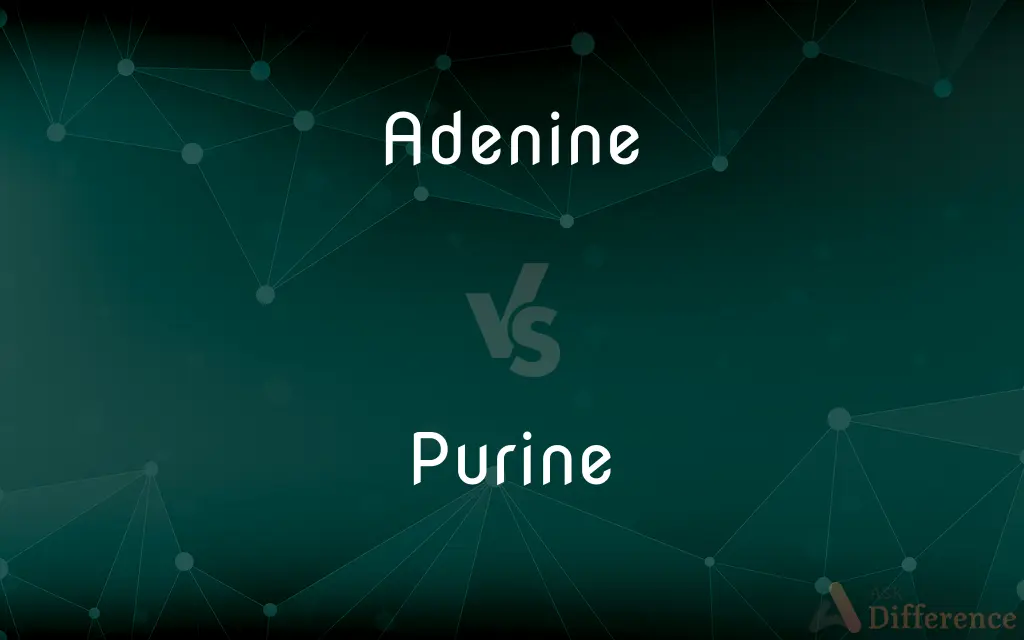Adenine vs. Purine — What's the Difference?
By Fiza Rafique & Maham Liaqat — Updated on March 19, 2024
Adenine is nucleobases used in forming nucleotides of genetic material, known for pairing with thymine in DNA & uracil in RNA, whereas purine is larger, heterocyclic aromatic organic compound that serves as base for adenine and guanine in DNA and RNA.

Difference Between Adenine and Purine
Table of Contents
ADVERTISEMENT
Key Differences
Adenine is a specific nucleobase that plays a crucial role in the structure of DNA and RNA, where it forms hydrogen bonds with thymine and uracil, respectively. This pairing is essential for the stability of the genetic material and the accurate transmission of genetic information. Purine, on the other hand, is a broader category of organic compound that includes not only adenine but also guanine, another nucleobase. Purines are characterized by their two-ring structure, which is critical for their function in the genetic code.
While adenine is directly involved in the storage and expression of genetic information, purine's role is more foundational, serving as the chemical backbone for adenine and guanine. This distinction highlights the difference in scope and function between the specific nucleobase adenine and the broader class of compounds represented by purines.
Adenine's importance in genetics is underscored by its presence in ATP (adenosine triphosphate), the primary energy currency of the cell, and in cofactors such as NAD and FAD, which are essential for metabolic processes. Purines, including adenine, play key roles beyond genetics, contributing to cellular energy transactions and signal transduction mechanisms.
The synthesis of adenine in the cell occurs through a series of enzymatic reactions that form part of the purine synthesis pathway. This pathway not only produces adenine but also leads to the formation of guanine, demonstrating the interconnectedness of purine metabolism and genetic material production. Purines, including adenine, are synthesized de novo or recycled through salvage pathways, indicating the cell's ability to efficiently manage its resources.
Comparison Chart
Definition
A nucleobase found in DNA and RNA.
A class of molecules including adenine.
ADVERTISEMENT
Chemical Structure
Part of the purine family, with a single-ring structure.
Two-ring nitrogenous base structure.
Role in Genetics
Pairs with thymine in DNA and uracil in RNA.
Serves as a base for nucleobases adenine and guanine.
Involvement in Cellular Processes
Integral to ATP, NAD, and FAD.
Foundation for adenine and guanine, involved in energy and signal transduction.
Synthesis
Produced via the purine synthesis pathway.
Includes adenine and guanine synthesis.
Compare with Definitions
Adenine
A component of DNA and RNA, pairing with thymine or uracil.
Adenine forms hydrogen bonds with thymine in DNA.
Purine
Essential for genetic structure and function.
Purine bases ensure the stability and integrity of genetic material.
Adenine
Integral to ATP, carrying energy within cells.
ATP's adenosine component includes adenine.
Purine
A two-ring nitrogenous base structure.
Purine bases include adenine and guanine.
Adenine
Produced through the purine synthesis pathway.
Cells synthesize adenine as part of nucleotide production.
Purine
Found in DNA and RNA as adenine and guanine.
Purines form hydrogen bonds with specific pyrimidines in nucleic acids.
Adenine
Found in cofactors like NAD and FAD.
Adenine is part of the structure of NAD, essential for metabolism.
Purine
Involved in cellular energy and signaling.
Purine derivatives play roles in energy transfer and cellular communication.
Adenine
Recycled in cells through salvage pathways.
Adenine can be salvaged and reused in nucleotide synthesis.
Purine
Can be synthesized de novo or recycled.
Cells can synthesize purine nucleotides from scratch or recycle them.
Adenine
Adenine (A, Ade) is a nucleobase (a purine derivative). It is one of the four nucleobases in the nucleic acid of DNA that are represented by the letters G–C–A–T. The three others are guanine, cytosine and thymine.
Purine
Purine is a heterocyclic aromatic organic compound that consists of two rings (pyrimidine and imidazole) fused together. It is water-soluble.
Adenine
A purine base, C5H5N5, that is the constituent involved in base pairing with thymine in DNA and with uracil in RNA.
Purine
A colourless crystalline compound with basic properties, forming uric acid on oxidation.
Adenine
A base, C5H5N5, found in certain glands and tissues, which pairs with thymine in DNA and uracil in RNA.
Purine
A double-ringed, crystalline organic base, C5H4N4, that is the parent compound of a large group of biologically important compounds.
Adenine
(biochemistry) purine base found in DNA and RNA; pairs with thymine in DNA and with uracil in RNA
Purine
Any of a group of substituted derivatives of purine, including the nitrogen bases adenine and guanine, which are components of nucleic acids. Uric acid, caffeine, theobromine, and theophylline are also purines.
Purine
(organic compound) Any of a class of organic heterocyclic compounds, composed of fused pyrimidine and imidazole rings, that constitute one of the two groups of organic nitrogenous bases (the other being the pyrimidines) and are components of nucleic acids.
Purine
Any of several bases that are derivatives of purine
Purine
A colorless crystalline nitrogen-containing organic base; the parent compound of various biologically important substances
Common Curiosities
How do adenine and purine contribute to genetic information storage?
Adenine pairs with thymine (or uracil in RNA) to store genetic information, while purines as a whole (adenine and guanine) are essential for the structure and function of nucleic acids.
How are purines synthesized in the cell?
Purines are synthesized through a complex pathway involving multiple enzymatic reactions, which can lead to the production of both adenine and guanine.
What is the difference between adenine and purine?
Adenine is a nucleobase within the purine family, which includes both adenine and guanine, characterized by a two-ring structure.
Are adenine and purine found in both DNA and RNA?
Yes, adenine is found in both DNA and RNA, and purine bases, including adenine and guanine, are integral components of both types of nucleic acids.
Can purines be recycled within the cell?
Yes, purines can be recycled through salvage pathways, allowing cells to efficiently use existing nucleobases for new nucleotide synthesis.
What role does adenine play in cellular energy transfer?
Adenine forms part of ATP, the primary energy carrier in cells, facilitating energy transfer for metabolic processes.
What is the significance of purines in cellular signaling?
Purine derivatives, such as cyclic AMP, play crucial roles in signal transduction processes, mediating cellular responses to external signals.
How do adenine and purine levels affect human health?
Imbalances in purine metabolism can lead to disorders such as gout, characterized by elevated uric acid levels, underscoring the importance of purine regulation.
What research is being conducted on adenine and purine?
Research focuses on understanding their roles in genetics, energy transfer, and disease, aiming to develop treatments for related disorders.
Are adenine and purine interchangeable in genetic coding?
While both are essential for genetics, they are not interchangeable; adenine has specific roles, particularly in base pairing, that are distinct from guanine's functions.
Share Your Discovery

Previous Comparison
Empowerment vs. Disempowerment
Next Comparison
Soonest vs. EarliestAuthor Spotlight
Written by
Fiza RafiqueFiza Rafique is a skilled content writer at AskDifference.com, where she meticulously refines and enhances written pieces. Drawing from her vast editorial expertise, Fiza ensures clarity, accuracy, and precision in every article. Passionate about language, she continually seeks to elevate the quality of content for readers worldwide.
Co-written by
Maham Liaqat















































